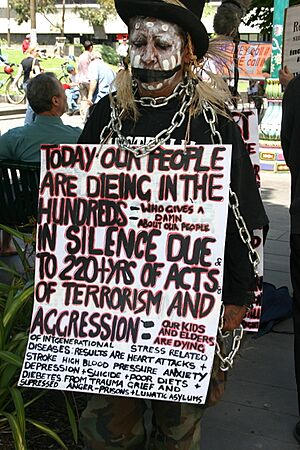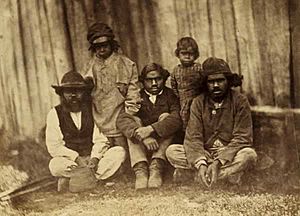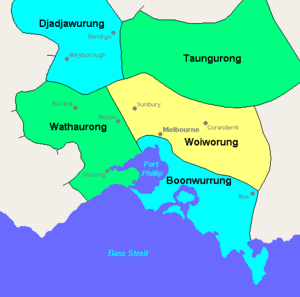Djadjawurrung facts for kids
| Total population | |
|---|---|
| 2,500 | |
| Regions with significant populations | |
| Languages | |
| Djadjawurrung, English | |
| Religion | |
| Australian Aboriginal mythology, Christianity | |
| Related ethnic groups | |
| Bunurong, Taungurung, Wathaurong, Wurundjeri see List of Indigenous Australian group names |

The Dja Dja Wurrung (pronounced Ja-Ja-war-rung) are an Aboriginal Australian people. They are also known as the Djaara or Jajowrong people. They are the traditional owners of a large area of land in central Victoria, Australia. This land includes the areas around the Loddon and Avoca rivers, near Bendigo. The Dja Dja Wurrung are part of the Kulin alliance. This is a group of Aboriginal peoples in Victoria. The Dja Dja Wurrung have 16 different family groups, called clans. Their system for tracing family lines is called patrilineal. This means family connections are passed down through the father's side. Like other Kulin peoples, they have two main groups, or moieties. These are named after Bunjil the eagle and Waa the crow.
Contents
- Understanding the Dja Dja Wurrung Name
- The Dja Dja Wurrung Language
- Dja Dja Wurrung Traditional Lands
- A Glimpse into Dja Dja Wurrung History
- Moving Forward: Resettlement
- Community Structure and Land Use
- Dja Dja Wurrung Clans
- Diplomacy and Tanderrum
- Official Recognition and Agreement
- Other Names and Words
Understanding the Dja Dja Wurrung Name
The name Dja Dja Wurrung is interesting. It seems to combine the word for "yes" (djadja) with "mouth" (wurrung). This is a bit special. Many other language groups in the area use their word for "no" in their name. The Dja Dja Wurrung language had two main ways of speaking, an eastern and a western style.
The Dja Dja Wurrung Language
The Dja Dja Wurrung language is part of the Kulin languages family. In 1878, about 700 words were written down by Joseph Parker. Later, in 1904, R. H. Mathews created a basic guide to its grammar. This was published in German.
Dja Dja Wurrung Traditional Lands
The Dja Dja Wurrung's traditional lands cover a huge area. It's about 16,000 square kilometers. This land includes the upper parts of the Loddon and Avoca rivers. It stretches east through Maldon and Bendigo to near Castlemaine. To the west, it reaches St. Arnaud. The land also includes the area near Lake Buloke. In the north, it touches Boort and Donald. To the south, it extends to Creswick and Daylesford. The southwest border is near Navarre Hill and Mount Avoca. Places like Stuart Mill, Natte Yallock, and Emu Flat are also on Dja Dja Wurrung land.
A Glimpse into Dja Dja Wurrung History
The Dja Dja Wurrung people have a deep connection to their land. This comes from their spiritual beliefs, known as the Dreaming. In the Dreaming, powerful beings created the world, the people, and their culture. The Dja Dja Wurrung were part of large trade networks. These networks allowed goods and information to travel long distances. For example, a special stone called Tachylite was found near Spring Hill. Stone tools made from this material have been found across Victoria. This shows it was an important trade item.
Sadly, diseases like smallpox affected the Dja Dja Wurrung. These diseases may have arrived from the north. They swept through the community in 1789 and 1825. In 1840, a count showed only 282 Dja Dja Wurrung people. This was a big drop from the estimated 900–1900 people in 1836. That was when the first European explorer, Thomas Mitchell, passed through their land. Mitchell described the land as very fertile. European settlers, called squatters, began to arrive the next year. They wanted to claim land for their farms. The Dja Dja Wurrung explained the epidemics through their stories. They believed a giant snake, the Mindye, was sent by Bunjil. It blew magic dust to punish people who were not following the rules.
Munangabum: A Strong Leader
Munangabum was an important leader of the Liarga balug clan. He was also a spiritual leader, or neyerneyemeet, for the Dja Dja Wurrung. He lived through the smallpox epidemics. He also guided his people during the arrival of European settlers in the 1830s and 1840s.
In 1841, Munangabum was shot and injured by settlers. His friend Gondiurmin died. Three settlers were later arrested but were found not guilty. This was because Aboriginal people were not allowed to give evidence in court at that time. Munangabum was later killed in 1846 by a leader from another clan.
Challenging Times: Massacres
When Europeans settled in Western Victoria in the 1830s and 1840s, there was often conflict. Aboriginal people sometimes resisted by taking sheep. This led to clashes and, sadly, sometimes massacres of Aboriginal people. The Dja Dja Wurrung faced two waves of settlement. One came from the south starting in 1837. Another came from the north starting in 1845.
Very few reports of violence against Aboriginal people led to court cases. Even when they did, the cases were dismissed. This was because Aboriginal people could not give evidence in court. A settler named Neil Black wrote in 1839 about the common attitude. He said that to get land, one might need to "slaughter natives right and left." He noted that it was widely understood that settlers might need to use such methods.
Many killings were reported in Dja Dja Wurrung territory up to 1859. These events caused great loss and suffering for the Dja Dja Wurrung people.
The Loddon Aboriginal Protectorate Station
Edward Stone Parker was sent from England to be an Assistant Protector of Aborigines. His job was to protect Aboriginal people in the Port Philip district. He arrived in Melbourne in 1839. Parker was assigned to the Loddon District. His duties included protecting Aboriginal people from harm and injustice. He also aimed to help them adapt to European ways.
Parker set up a station at Franklinford in 1841. The Dja Dja Wurrung called this area Larne-ne-barramul, meaning "habitat of the emu." Mount Franklin nearby was known as Lalgambook. Franklinford became a key place for the Dja Dja Wurrung in the 1840s. They received some protection and food there. However, they tried to continue their traditional ways of life as much as possible. Parker hired a doctor to treat the many illnesses.
Parker also tried to take European settlers to court for harming Aboriginal people. But these cases were dismissed. This was because Aboriginal people were not allowed to give evidence in court. This made it very hard to get justice for crimes against them.
The government cut funding for the protectorate in 1843. The protectorate officially ended in 1848. About 20 or 30 Dja Dja Wurrung people were living at the station then. Six Dja Dja Wurrung men and their families settled at Franklinford. Sadly, most of them died from accidents or lung diseases. Tommy Farmer (Beernbarmin) was the last survivor of this group. He left the land in 1864 and later joined the Coranderrk reserve.
The Impact of Disease
While conflicts and violence caused harm, diseases had an even bigger impact. Smallpox epidemics had already reduced the population before Europeans arrived. From the late 1830s, contact with Europeans brought new illnesses. These included colds, flu, chickenpox, measles, and scarlet fever.
Groups who had more contact with settlers were affected the most. Staying in the same camping spots for longer also made them sick. When several Dja Dja Wurrung died at Franklinford in 1841, many left the station. By 1852, the Dja Dja Wurrung population was estimated at only 142 people. Just 15 years earlier, there had been between one and two thousand people.
The Victorian Gold Rush Era
The Victorian Gold Rush began in 1851. This put even more pressure on the Dja Dja Wurrung. Thousands of gold diggers arrived. Many sacred sites were disturbed. The gold rush also created a need for workers on farms. So, many settlers hired Dja Dja Wurrung people. They worked as shepherds, stockriders, and domestic helpers. Those who could not find work sometimes begged for food and clothes. Alcohol became more available, leading to serious problems. Death rates increased during the gold rushes.
Some Dja Dja Wurrung people chose to move north. They wanted to avoid the difficulties of living near European settlements. A small number stayed at Franklinford with Parker. They farmed the land and sold their produce to nearby gold diggings.
The Jaara Baby Story
The Jaara baby was an Aboriginal Australian child. The child died sometime between the 1840s and 1860s. The child's remains were found in a tree in 1904. They were found with toys like feathers and a waist belt, and some European items. The remains were kept at Museum Victoria for 99 years. In 2003, they were returned to the Dja Dja Wurrung community.
Moving Forward: Resettlement
In 1864, an investigation looked into the conditions at Franklinford. It found the school was not good and the farms were abandoned. It was suggested that the children move to Coranderrk. Dja Dja Wurrung people at Franklinford were forced to move to the Coranderrk station. This land belonged to the Wurundjeri people. At that time, there were 31 adults and 7 children from the Dja Dja Wurrung.
Thomas Dunolly was a Dja Dja Wurrung child who was moved to Coranderrk. He later played a big part in the first organized protest by Aboriginal people. This protest aimed to save Coranderrk in the 1880s. Later, Caleb and Anna Morgan, who were descendants of Caroline Malcolm (who also moved to Coranderrk), were active members of the Australian Aborigines League. This group was founded in 1933–34.
In 2004, Aunty Susan Rankin, a Dja Dja Wurrung elder, peacefully reoccupied crown land at Franklinford. She called her camp the Going Home Camp. She asked the government to show documents proving their right to the land. Local officers admitted they could not find such documents.
Community Structure and Land Use
The Dja Dja Wurrung community was made up of 16 land-owning groups called clans. These clans spoke a similar language. They were connected by culture, shared interests, totems (special animal or plant symbols), trade, and marriage. Sometimes, other clans had limited access to land and resources. This depended on how much of a resource was available. For example, if fish supplies were low in a river, the clan owning that river might limit fishing. This helped make sure resources lasted. Like most Kulin territories, there were rules. Breaking these rules could lead to penalties. Today, traditional clan locations and language groups are not used in the same way. But descendants of Dja Dja Wurrung people still live in modern society. They work hard to preserve their culture.
Dja Dja Wurrung Clans
Before European settlement, there were 16 separate clans. Each clan had a headman.
| No | Clan name | Approximate location |
|---|---|---|
| 1 | Bial balug | Bealiba |
| 2 | Burung balug | Natte Yallock |
| 3 | Bulangurd gundidj | Mount Bolangum |
| 4 | Cattos run clan | Bridgewater |
| 5 | Galgal balug | Burnbank and Mount Mitchell |
| 6 | Djadja wurrung balug | unknown |
| 7 | Galgal gundidj | northwest of Kyneton |
| 8 | Gunangara gundidj | Larrnebarramul, near Mount Franklin |
| 9 | Larnin gundidj | Richardson River |
| 10 | Liarga balug | Mount Tarrengower and Maldon |
| 11 | Munal gundidj | Daylesford |
| 12 | Dirag balug | Avoca |
| 13 | Durid balug | Mount Moorokyle and Smeaton |
| 14 | Wurn balug | between Carisbrook and Daisy Hill |
| 15 | Wungaragira gundidj | upper Avoca River and near St Arnaud |
| 16 | Yung balug | Mount Buckrabanyule |
Diplomacy and Tanderrum
When people from other groups wanted to pass through Dja Dja Wurrung lands, a special ceremony called Tanderrum was performed. This ceremony allowed safe travel and temporary use of the land and its resources. It was a diplomatic event. It involved the landholders showing hospitality and exchanging gifts.
Official Recognition and Agreement
On March 28, 2013, the State of Victoria and the Dja Dja Wurrung people signed an important agreement. This was called the Recognition and Settlement Agreement. It formally recognizes the Dja Dja Wurrung people as the traditional owners of part of Central Victoria. The agreement covers land north of the Great Dividing Range near Daylesford. It includes parts of the Richardson, Avon, Avoca, Loddon, and Campaspe Rivers. It also includes Crown land in Bendigo, Lake Boort, and part of Lake Buloke. This agreement was the result of 18 months of talks. It settled native title claims that started in 1998.
At the signing ceremony, Victorian Attorney-General, Robert Clark, said the government was happy to reach this agreement. He noted it avoided expensive court cases. It also helps the Traditional Owner community build a strong future. A ceremony to celebrate the agreement was held in Bendigo in November 2013.
Other Names and Words
The Dja Dja Wurrung people have been known by several names over time. These include Djadjawurrung, Jarrung Jarrung, and Jajowrong.
Here are a few words from their language:
- pumpum (egg)
- pupup (baby)
- tjaka, tjakila (western dialect) or tjakala (eastern dialect) means "to eat"
- weka (to laugh)



